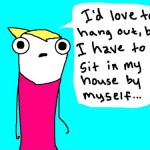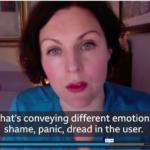Face to face meeting will surely continue to be the most useful and enjoyable way to connect in business, no matter how sophisticated virtual interaction becomes. Even when Virtual Reality has become so mainstream that events are routinely coordinated through multiple VR headsets, it will probably never beat the real thing – at least until human brains have evolved sufficiently – and that may take some time!
As those of us who have tried online dating know, it’s possible to feel you have connected deeply with someone in the digital world and have zero chemistry in person. Our brains and the memories laid down within them are linked to emotional experience, so people who make an impression in the flesh are more likely to stay with us and those relationships more likely to move forward in the real world. What we say is only a small part of making a lasting impression on another human being – non verbal cues, body language, smell, emotional history and many other factors are in the mix too.
For those really vital connections, I always meet the person face to face. And so, inevitably, we come to that most ubiquitous of business terms: Networking.
Some of us love getting out there, pressing the flesh, getting our energy from other people. I’m not one of them. As someone towards the introverted side of the spectrum, I’ve discovered that while I really enjoy the company of others, I get my energy from time alone to recharge and contemplate. Although not generally lacking in confidence, I enjoy small groups and one on one better than large crowds. So all the parties, large networking events, festivals, conferences etc. that come with the territory of running a creative company can sometimes be a drain on the energy needed to push ahead, rather than a spur to collaboration as they are intended to be.
I am not alone in this, and agree with author and co-founder of the Quiet Revolution Susan Cain who, in her fantastic book Quiet: The Power of Introverts in a World That Can’t Stop Talking (a revelatory book for me) who argues that we should not fight or repress our introversion, but should embrace it. I spent many years pretending to be an extrovert, because the society I live in does not accord much respect to my more introspective nature and need for quiet, space, reflection and perspective. You only have to google the words introverted and extroverted to discern a cultural bias. But this is society’s loss; there are many positive aspects to being on the introverted side of the spectrum and the more obstructive things can be managed, with a little self- awareness.
The tendency to be introverted or extroverted can be situation and company dependent, and it is on a fluid spectrum so don’t be too quick to box yourself into a category, but it does help to be realistic about how you interact and what brings out your confidence or inhibition. Remember, introversion and confidence are not mutually exclusive and introverts are not necessarily “shy” (although we often are) – we just have a way of processing the world that has not been properly expressed in our culture until very recently.
A useful pre-networking event strategy for introverts is deep research (one of my favourite things)! Research an event’s attendees before you go. This foreknowledge means you can zero in on those who seem on your wavelength, armed with a nugget of information from your exhaustive online digging the night before. Another is to have a pre-decided exit time (although you will hopefully not stick to it). I don’t advise going with friends because if you’re anything like me, you will probably just talk to them.
Over the years I have learned to respect the calm inner voice that says “it’s time to go” but also not listen to the panicked inner voice that says “get me out of here!”. The former is telling me that it’s time to recharge, the latter is not giving the event a chance because of social discomfort – which can ultimately mean losing out.
So force yourself to stay for an hour, at least – and remember that there are several people there in exactly the same boat as you, however they appear. Human beings vary in the way they negotiate these situations but you can be sure that at any large networking event there are many introverted as well as extroverted people present and if they can stick it out for a bit, so can you.
I was at a swanky event years ago with a friend and was bemoaning my awkwardness to him afterwards when he said “how do you think I felt – I was the only brown face in the room”. It really made me think, and put my own difficulties into perspective. Sometimes we’re so inside our own heads that we don’t think about the internal experience of other people.
That first conversation is the most awkward to kick off, and after this people join your group so that it flows more easily. You eventually find that you’re enjoying it, and time has flown as much as the wine. If no one is approaching you, wait for one of your pre-researched targets to become available and do it yourself. If it doesn’t go well you will probably never encounter this person again so it matters very little – and if it does you may have found a long term partner, collaborator or funder for your work.
As Susan Cain attests, extrovert is not always best. Remember that the qualities of thoughtfulness, perspective, listening ability, authenticity and focused attention are attractive in these situations too. In discussions I often have a different approach and communication style to extroverts, and this can be an incredibly useful thing in a group dynamic because I am not afraid to speak out. It aids group cohesion and helps to include those around the table who are not talking.
The qualities of introverts are essential to running a business well. Mixing extroverts and introverts according to their strengths within organisations makes very good business sense – just look at Apple, founded by introvert Steve Wosniak and extrovert Steve Jobs – now the most successful company on the planet.





